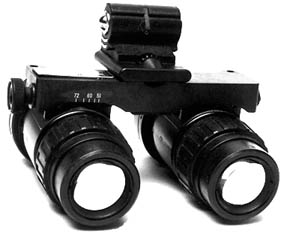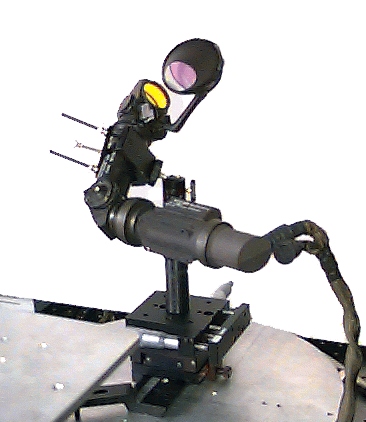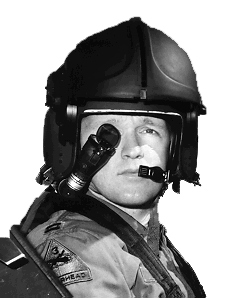|
Since
the 1970s, the trend in Army aviation has been to rely
increasingly on helmet-mounted display (HMD) devices or systems
to provide the aircrew with pilotage imagery, flight
information, and fire control imagery and symbology. The first
such system was the AN/PVS-5 series night vision goggle (NVG),
circa 1973. This system was the aviation version of the SU-50,
the earliest HMD used by the infantry. It consisted of 2nd
generation image intensification ( I2 ) devices
"hung" on the existing flight helmet. By 1989, the
AN/PVS-5 had been replaced by the AN/AVS-6 Aviator’s Night
Vision Imaging System (ANVIS), the first I2 HMD
designed specifically for Army aviation use. ANVIS is a passive,
binocular, 3rd generation I2 system and
has improved sensitivity and resolution over the 2nd
generation I2 tubes. ANVIS is attached to current
Army helmets, e.g., SPH-4B and HGU-56/P, using specially
designed mounting brackets. The recent addition of symbology to
the standard ANVIS has produced the AN/AVS-7 head-up display
(HUD). [Note: There is some disagreement among leaders in the
field of HMD research and development as to whether or not ANVIS
and its predecessor, the AN/PVS -5 NVG, are "true"
HMDs.]

ANVIS6 goggles
When
the AH-64 Apache attack helicopter was fielded in the early
1980s, the head-mounted I2 sensors in NVGs were
replaced as the imagery source by a forward-looking infrared (FLIR)
sensor, the Pilot’s Night Vision System (PNVS), mounted on the
nose of the aircraft. Imagery from this sensor is displayed on a
miniature 1-inch diameter cathode ray tube (CRT) and optically
relayed to the eye. This system is known as the Integrated
Helmet and Display Sighting System (IHADSS). It is a monocular
system, presenting imagery to the right eye only. The IHADSS was
the first integrated HMD, where the helmet, head tracker, and
display were designed as a single system. The success of IHADSS
in Army aviation has greatly influenced and contributed to the
proliferation of HMD programs
Currently,
the Army is developing the RAH-66 Comanche reconnaissance
helicopter. This aircraft will utilize a partially overlapped
biocular HMD, known as the Helmet Integrated Display Sight
System (HIDSS). It consists of a pilot retained unit (PRU) and
an aircraft retained unit (ARU). The PRU is the basic helmet
with visor assembly. The ARU is a front piece consisting of two
image sources and optical relays attached to a mounting bracket.
The HIDSS development and validation phase design, which uses
two miniature, 1-inch, CRTs as image sources, provides a 30º
(V) by 52º (H) field-of-view (FOV) with a 17º overlap region.
However, miniature displays based on flat panel (FP)
technologies [e.g., liquid crystal (LC) and electroluminescence
(EL)] will very likely replace the CRTs in subsequent program
phases.

HIDSS relay optics
The
trend for increasing reliance on HMDs in aviation, as well as in
other sectors of the Army, will continue. The U.S. Army Night
Vision and Electronic Sensor Directorate (NVESD), Fort Belvior,
Virginia, is developing an HMD under the Advanced Helicopter
Pilotage (AHP) program. The AHP HMD is biocular, providing the
same imagery to each eye. Its two optical channels each provide
a 40º monocular circular FOV. When mounted on a helmet, the
system provides a 30º (V) x 50º (H) total FOV with a 30º
binocular overlap region.
The
United States and the United Kingdom have collaborated on the
Covert Night/Day Operations for Rotorcraft (CONDOR) program.
CONDOR is a research platform for demonstrating advanced
visionics concepts and includes a variable FOV HMD based on high
resolution miniature active matrix liquid crystal
displays
(AMLCDs).
The
U.S. Army and the Defense Advanced Research Projects Agency (DARPA)
have funded a number of additional aviation HMD concepts based
on FP technologies. These include the Miniature Flat Panel for
Aviation (MFP/A) program which has as its goal the investigation
of using miniature FP technology displays in the development of
an HMD for use in rotary-wing aircraft and the Aircrew
Integrated Helmet System (AIHS) Comanche Compatibility program
which has as its goal the development of an HMD design using the
Helmet Gear Unit No. 56/P (HGU-56/P) flight helmet as the
platform.
|
Summary
of Current rotary-wing HMD programs.
|
|
Program
|
|
Fielded
|
Programs
in Development
|
|
Highlights
|
ANVIS
|
IHADSS
|
HIDSS
|
MFP/A
|
AVS/Condor
|
AIHS-H
|
AIHS-K
|
|
Vehicle
|
Rotocraft
|
AH-64
Apache(1)
|
RAH-66
Comanche
|
Rotocraft
|
Rotocraft
|
RAH-66
Comanche
|
RAH-66
Comanche
|
|
Program
Type
|
Production
|
Production
|
EMD
|
R&D
|
R&D
|
PI
|
PI
|
|
Mass
|
22
kg(2)
|
1.8
kg
|
2.6
kg
|
--
|
--
|
--
|
--
|
|
CM
longit
|
30
mm(2)
|
20
mm
|
34
mm
|
--
|
--
|
--
|
--
|
|
CM
vertical
|
37
mm(2)
|
27
mm
|
48.4
mm
|
--
|
--
|
--
|
--
|
|
Helmet
|
All
|
Custom
|
Custom
|
HGU-56P
|
HGU-56P
|
HGU-56P
|
HGU-56P
|
|
LLLTV
|
--
|
ANVIS
|
P
|
--
|
--
|
ANVIS
|
ANVIS
|
|
FLIR
|
--
|
1st
gen
|
2nd
gen
|
2nd
gen
|
2nd
gen
|
2nd
gen
|
2nd
gen
|
|
Channels
|
Binocular
|
Monocular
|
Biocular
|
Biocular
|
Biocular
|
Biocular
|
Biocular
|
|
FOV
|
40°
|
40°
X 30°
|
52°
X 30°
|
50°
X 30°
|
60°-100°
X 30°
|
52°
X 30°
|
52°
X 30°
|
|
Overlap
|
40°
|
N/A
|
18°
|
30°
|
20°
to 50°
|
30°
|
30°
|
|
Exit
pupil
|
--
|
10mm
|
>15mm
|
>15mm
|
15mm
|
>15mm
|
>15mm
|
|
Eye
relief
|
15-30mm
|
10mm
|
>25mm
|
>25mm
|
>25mm
|
>25mm
|
>25mm
|
|
Eye
clearance
|
15-30mm
|
13mm
|
>22mm
|
>22mm
|
>22mm
|
>22mm
|
>22mm
|
|
Display
|
18mm
I2 P22 phosphor
|
1"
CRT P43 phosphor
|
1"
CRT P53 phosphor
|
1280X1024
AMEL
|
1280X1024
AMLCD
|
1280X1024
Flat Panel
|
1280X1024
Flat Panel
|
|
Color
|
Monochrome
|
Monochrome
|
Monochrome
|
Monochrome
|
Color
|
Monochrome
|
Monochrome
|
|
TV
lines/pixels
|
~2000-3000
|
809
|
960
|
960/809/525
|
960
|
960
|
960
|
|
Roll
compensation
|
Yes
|
No
|
Yes
|
No
|
No
|
Yes
|
Yes
|
|
Electronics
|
Analog
|
Analog
|
Analog
|
Digital
|
Digital
|
Digital
|
Digital
|
|
Modules
|
--
|
LRU
|
SEM-E
|
6U
VME
|
9U
VME
|
Sem-E
|
SEM-E
|
|
Latency
|
1.3msc(x)
|
<
17msec
|
<
66msec
|
--
|
21
msec
|
<
42msec
|
<
42msec
|
|
Egress
|
Breakaway
|
Breakaway
|
QDC
|
--
|
--
|
QDC
|
QDC
|
|
Sponsor
|
NVESD
|
U.S.
Army AAHPMO
|
U.S.
Army Commanche PMO
|
U.S.
Army Natick RDE
|
U.S.
Army AATD
|
U.S.
Army ACTSPMO
|
U.S.
Army ACTSPMO
|
|
Company
|
Multiple
|
Honeywell
|
Kaiser
|
Honeywell
|
Huges
|
Honeywell
|
Kaiser
|
|
Star/Duration
|
1980-present
|
6/85-present
|
1/93-present
|
3/94-present
|
1/94-present
|
8/95-present
|
8/95-present
|
|
Progress
|
25,000
units
|
1300
units
|
3
units
|
1
unit
|
--
|
Passive
HMD
|
Passive
HMD
|
|
|
MFP/A
- Miniature Flat Panel for Aviation; AVS - Advanced
Visionics System; A1HS-H - Aircrew Integrated Helmet
System - Honeywell Inc.; A1HS-K - Aircrew Integrated
Helmet System - Kasier Electronics; EMD - Engineering
Manufacturing and Development; P1 - Preplanned Product
Improvements; LLLTY - Low Light Level Television; LRU -
Line Replaceable Unit; SEM-E Standard Electronic Module,
Format E; VME- Virtual Module European; QDC - Quick
Disconnect; AAH - Advanced Attack Helicopter; PMO
Project Manager's Office; AATD - Aviation Applied
Technology Directorate; ACIS - Aircrew Integrated
System; NVESD - Night Vision and Electronic Sensor
Directorate;
Notes: (1) Also used on Italy's A-129 Agusta
helicopter.
(2) Based on SPH-4B w/ANVIS and battery pack.
(3) Based on phosphor persistence; No measurable
electronic delay.
(4) Quantities; AH-64 (807) units(), A-129 (87 units),
spares (.400 units) with two HMD's per unit.
|
For
Army aviation, the purpose of the HMD is to assist the aviator
in the performance of various missions. Each type of mission
requires the aviator to perform a certain number of complex
tasks. The performance of these tasks is impacted by aviator
skills and capabilities (user properties), and by the
characteristics of the HMD. The operational environment may
include high speed, low level flight, during low illumination
and/or adverse weather conditions. Eggleston developed a model
which maps aviator tasks (e.g., navigation, unmasking maneuver,
etc.), user properties (e.g., perception, organization, etc.),
and HMD characteristics (e.g., FOV, resolution, etc.) for
specific missions and mission elements. This type of analysis is
essential in ensuring an optimal HMD design which meets the
needs of the aviator and the mission.
The
overall goal of HMDs in Army rotary-wing aviation is to
effectively interface the aviator/crewmember with the aircraft
and its associated systems, which allows the aviator to acquire
and maintain situational awareness (state of knowledge or mental
model of the surroundings). The HMD performs one or more of the
following functions: (a) To display pilotage or gunnery imagery
from I2 or FLIR sensors, (b) To present strategical,
tactical, and operational data on demand, serving as an
information management system, and (c) To sense head/eye
position and motion for the purpose of designating targets,
directing sensors and weapons, and activating switches. In
general, well designed HMDs should enhance aviator situational
awareness and increase mission effectiveness . The modern HMD is
not a new concept. Its invention has been attributed to Gordon
Nash, a British researcher, who explored alternative methods of
providing additional information to the aviator in the 1950's.
Adam Marshall traces the concept of using the helmet as a
platform for a fire control (weapon aiming) back to 1916, when
Albert Bacon Pratt developed and received patents for an
integrated gun helmet, perhaps the very first helmet-mounted
sight (HMS). This concept was revisited in the Helmet Sight
System (HSS) used in the U.S. Army’s AH-1 Cobra attack
helicopter in the 1970's. The U.S. Navy’s Visual Target
Acquisition System (VTAS), developed in the 1960's, was the
first fully operational visually coupled sighting system.
[However, the system was abandoned due to lack of sufficient
missile fire control technology.] For Army aviation, the
AN/PVS-5 NVG was the first pilotage imagery HMD (first tested in
1973), and the IHADSS was the first integrated HMD (fielded
since 1985).
Simply,
an HMD projects head-directed sensor imagery and/or fire control
symbology onto the eye, usually superimposed over a see-through
view of the outside world. As such, HMDs offer the potential for
enhanced situation awareness and effectiveness. However, their
design and implementation are not without problems and
limitations. Virtually every HMD, concept or fielded system,
suffers from one or more deficiencies, such as high
head-supported weight, center of mass (CM) off-sets, inadequate
exit pupil, limited FOV, low brightness, low contrast, limited
resolution, fitting problems, and low user acceptance. Of the
potential problems with HMDs, none are more troublesome than
those associated with the interfacing of the system with the
human user. The wide variation in head and facial anthropometry
makes this a formidable task, requiring HMD designs rich in
flexibility and user adjustments.
Fielded
systems
To
date, two HMD systems have been fielded in U.S. Army aviation,
the ANVIS and the IHADSS. These systems are vastly different in
design and implementation. ANVIS is a combined sensor/display
optics package which mounts unto existing aviator helmets by
means of a visor assembly mounting bracket. The ANVIS is
binocular (100% overlap) and uses 3rd generation I2
sensors, which being head-mounted do not require an additional
head tracking system. Typical ANVIS optical characteristics (for
procurements prior to December 1996) include: a focus range of
28 cm (11 inches) to infinity, unity (1x) magnification, 27-mm
effective focal length objective (f/1.2), 27-mm effective focal
length eyepiece lens, resolution of greater than 0.82 cycles/milliradian
(cy/mr), minimum 2000x brightness gain ( 3000x for newer
versions), -6 to +2 diopter eyepiece focus adjustment, and a
52-72 mm interpupillary distance (IPD) adjustment. The ANVIS
housing can be flipped up or down and has a 10-G breakaway
feature. A tilt adjustment of approximately 8º is provided.
There is a minimum vertical and fore/aft adjustment range of 16
mm. They operate off of one lithium or two "AA"
batteries. A dual battery pack is VelcroTM mounted on
the rear of the helmet to improve the CM. A summary of ANVIS
optical and electro-optical (EO) specifications is presented in
Table 1.1. Additional summaries of ANVIS performance
characteristics are provided by McLean et al. (1997);
Harding et al. (1996)
DeVilbiss, Ercoline, and Antonio (1994); Brickner (1989); and
Verona and Rash (1989).
IHADSS
is a monocular design with imagery provided to the right eye
only. Where ANVIS integrates the I2 sensors into the
HMD, IHADSS depends on a FLIR sensor located on the nose of the
aircraft.

IHADSS
The
IHADSS HMD consists of a helmet, visor housing with visor (clear
and tinted are provided), miniature CRT image source, head
tracker, and display optics. Lead sulfide detectors, mounted on
the helmet, are part of the EO head tracking system which slaves
the nose-mounted FLIR to the aviator’s head motion. The
headborne components of IHADSS are called the integrated helmet
unit (IHU) and the combination of the CRT and display optics is
called the helmet display unit (HDU) (Figure 1.13). The last
element in the HDU optics is a combiner (beamsplitter) which
reflects the HMD imagery into the aviator’s eye. The combiner
is a multilayer dichroic filter on a neutral density glass
substrate which has its reflective characteristics maximized for
the P43 phosphor used in the CRT. IHADSS performance
specifications include a 30º (V) x 40º (H) FOV, unity (1x)
magnification, a 10-mm exit pupil, a nominal ± 3 diopters
optical focus range, and a 10-mm optical eye relief.
|